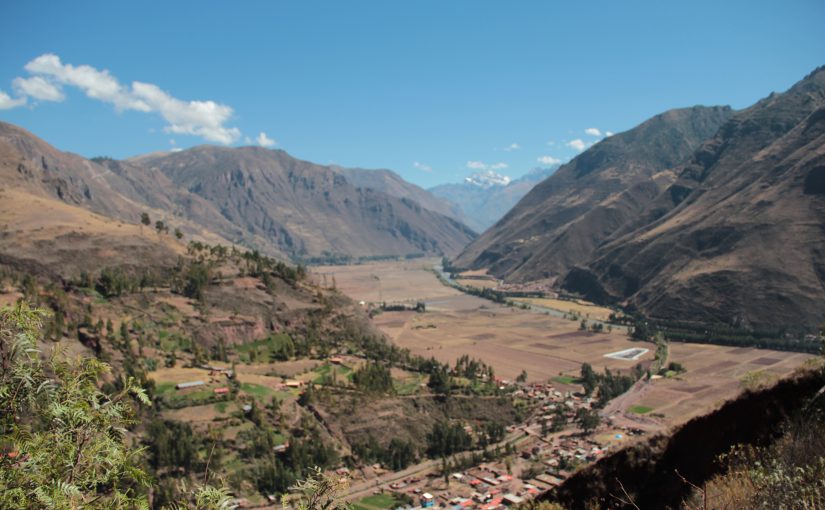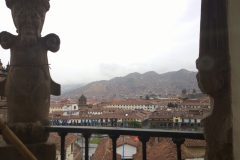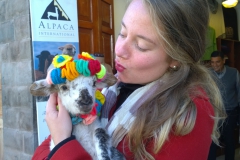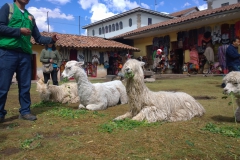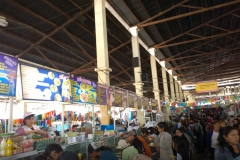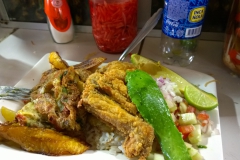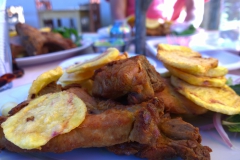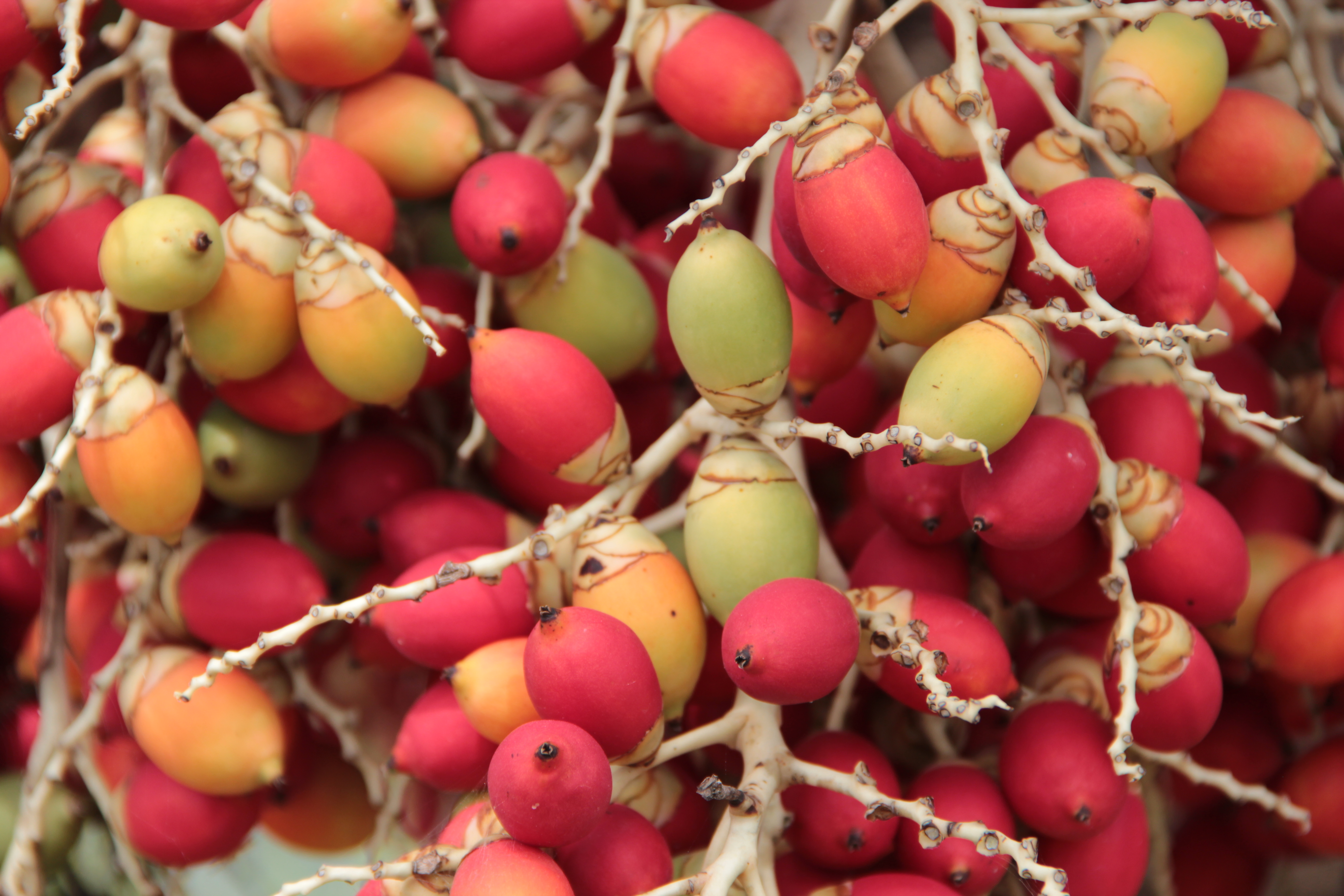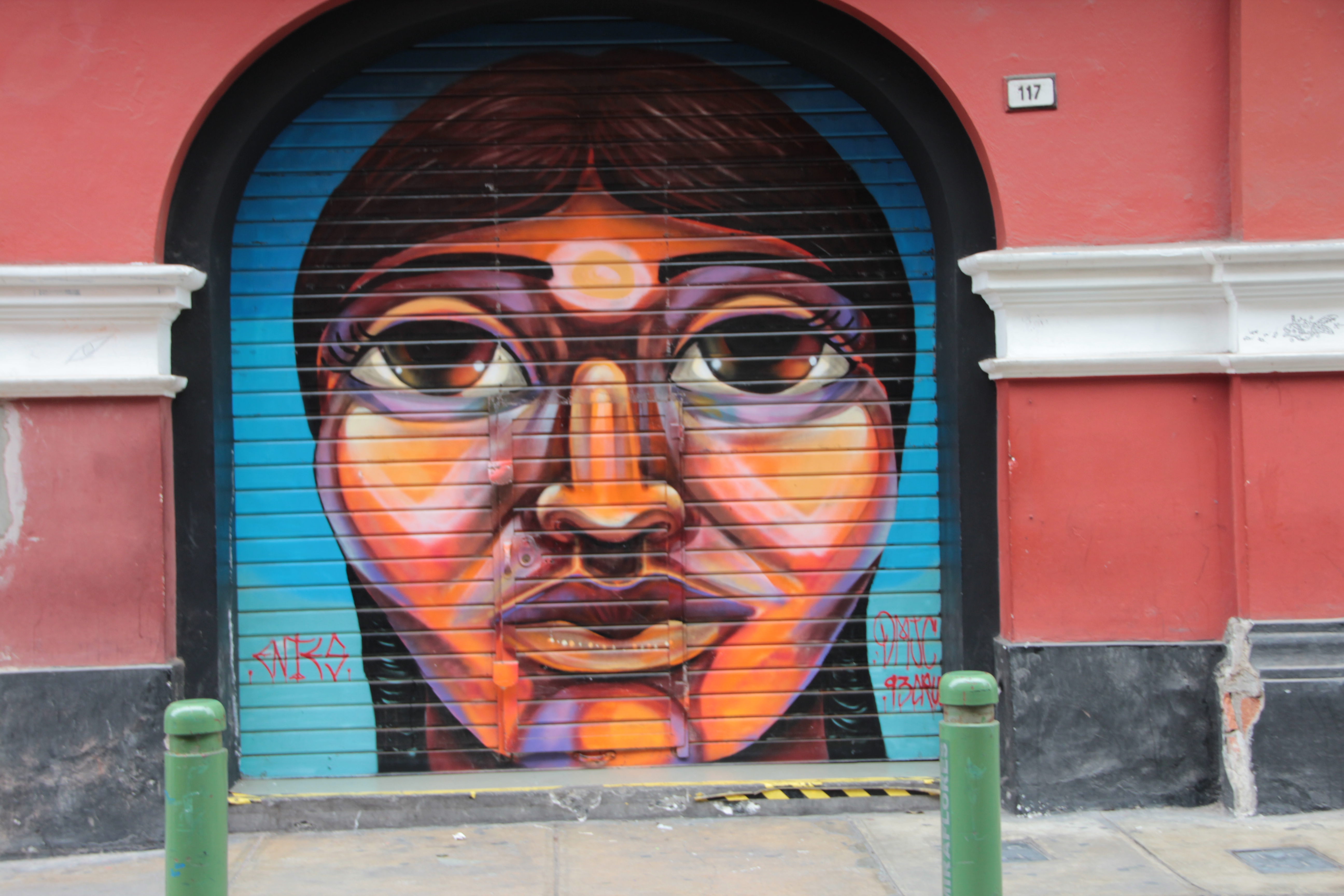[Dutch version below pictures]
During our week in Lima we determine our new destination: Cusco. Because national flights are pretty affordable in Peru, we book a one way ticket and are in Cusco within the hour.
During our flight we have our first meeting with the notorious Peruvian mountains, snowy and untouched mountain peaks become our view. You can do beautiful expeditions to these mountains.. but we are not planning to. In this case we rather enjoy the view sitting down in a comfy chair :).
We stay in Cusco for a week, this time at the “Bright Hostel”. A basic hostel with friendly staff and, most importantly, hot water (not warm, hot we want it).
The hostel is located in an alley about five minutes out of the city centre, with a lovely view of the mountain and surrounding neighbourhoods of the city. We encounter a painting club a few times in the mornings, painting this striking view.
Unfortunately the alley itself is very dirty and every day we need to jump around the trash to get home.
Upon arrival in Cusco we see a lot of rainbow flags, we are very impressed by the open attitude for gay rights! Especially for a South American country. At one point we see so many of these flags that we get a little suspicious.
We research it and it turns out that this rainbow flag is simply the flag of the city of Cusco. Nothing about gay rights (unfortunately). Luckily we were naive enough to believe it for a few hours.
We’ve been warned a lot about altitude sickness in this area. Especially for these two Dutch gals, who normally live below sea level. Luckily the altitude doesn’t really bother us, just walk up the hills slowly. In any other situation we would have done that slowly too ;).
The cold however does surprise us. On the first day we are also taken aback by rain fall, which makes us doubt if we actually like Cusco.
Luckily our practical side takes over the emotional one, we buy ourselves a winter coat (yes, a winter coat!), throw on a scarf and give the city a second chance.
Because of the shitty weather we start off with a visit to the Inca museum, which turns out to be a very good start of the trip. The museum has extensive information on not only the history of Peru, but all surrounding countries that were part of the Inca empire once.
It gives a clear and complete idea about the pre-Ina people, how they lived and a chronological order of all developments until the Spanish arrival in the 16th century.
Because of this visit, we are able to put all other information of the week in a better context.
During the Inca empire, Cusco is the capital and therefore of course an important target during the Spanish suppression. A lot of Inca architecture gets destroyed and new, catholic buildings replace them.
However, they didn’t really think this through: during that period Cusco deals with a lot of earth quakes. After one of those earth quakes, Inca buildings would still be fine, but Spanish buildings would have gone down like sand castles.
The Spaniards learned from this. From that point on, they didn’t destroy the entire temple but left the foundation standing. On top of that original foundation they build the new buildings.
There is one church in the city, the Santo Domingo, which even shows three different layers of foundation. One pre-Inca, one Inca and one Spanish. Pretty special to see.
We aren’t aware of this history on our first night in Cusco.. why are all these people posing next to a wall like a bunch of idiots? The day after it becomes clear.
To get to know the city we again take part in a Free Walking Tour. We have a fantastic tour guide with a huge smile and a too difficult name.
On the Plaza de Armas he tells us about the history of Cusco and how Inca and Catholic culture has melted together into one nowadays. In the mornings a lot of people come to the cathedral to pray to God, but they have been able to integrate native traditions into the church as well.
The tour ends in a restaurant where we learn how to make Ceviche. After our Bambam experience in Lima we’re very interested in doing so.
So if you’re interested in eating some Ceviche, from now on we’re happy to make you some!
In Cusco we try to eat as much local food as we can and therefor go to the market a lot. The menu is again soup as a starter, followed by a hot meal. This mostly costs you about € 1,50! Good deal.
The local specialties here are meat of the alpaca and the guinea pig.
They call guinea pig Cuy (= kwie) because that sounds like the noise the animals make.
Unfortunately we didn’t try out guinea pig, but alpaca meat is very tasty. Tastes like a fine steak.
In the region of Cusco there are a lot of ruins from the Inca strongholds, which makes it an archaeological gold mine. Especially when it comes to water management, the Inca’s are far ahead of their time.
We are no archaeologists however and quickly find out that we rather enjoy some nice views than look at a few old rocks (oops, did we say that?).
During dinner one evening we are offered our first Cusquena beer by two Peruvian students. Bruce and Edwin both study some form of engineering and speak a little English.
Unfortunately Edwin needs to work the entire week, but with Bruce we agree that he will guide us to some spots he loves to visit himself. No better guide than a local!
Together with Bruce we go to Tipon. Tipon is also an archaeological site, which characterizes itself just like the other sites by a terrace shaped build up. In earlier days, the terraces make agricultural experiments in temperature and humidity possible. Bruce explains this to us in a mix of Spanish and English.
Tipon is mostly a peaceful and beautiful spot.
After Tipon we walk to one of Bruce’s hot spots to eat his favourite dish: chicharrón. Best described as fried pork chops – indeed very nice!
After a week of receiving and processing a lot of information, we take the bus to travel from Cusco to Puno.
Puno is mostly known because of the lake it’s build next to, Lake Titicaca. This is the highest commercially sailed lake in the world.
A part of the lake is habitat by the Uros people, a people who create their own islands by making a floating mass out of reed and clay. Nowadays they even have electricity due to solar panels.
Walking on the small islands feels funny, your shoe soaks into it a little bit like you’re standing in the mud. It’s very interesting to see how entire families organized their lives on these small islands.
Currently the main income for the Uros is tourism and that’s very noticeable in the attitude of the people. We are entertained with a tour, explanations and even some traditional songs, but with little enthusiasm.
We are glad that we chose to only to the half a day tour.
We’ve come to known Puno as a nice student city. There are a lot of sports activities outside, there is a book market and in the weekend there’s a fun school event to raise money for a biological research on the university.
After almost 2,5 week of Peru, it’s time to travel further.
At 5 am we enjoy our last Peruvian breakfast and leave with the first bus to Bolivia.
Tijdens onze week in Lima besluiten we dat we als volgende bestemming Cusco kiezen. Omdat binnenlandse vluchten in Peru goed betaalbaar zijn, boeken we een enkeltje en zijn we binnen een uur vliegen in Cusco.
Tijdens onze vlucht hebben we de eerst ontmoeting met de beruchte Peruaanse bergen, besneeuwde en ongerepte bergtoppen komen ons tegemoet. Hier kun je prachtige expedities naartoe doen.. maar dat zijn wij niet van plan. Wij genieten in dit geval liever zittend van het uitzicht :).
Ook in Cusco verblijven we een week, dit keer in “Bright Hostel”. Een basic hostel met vriendelijk personeel en, het allerbelangrijkste, heet water (niet warm, heet willen we het hebben).
Het hostel ligt in een steeg vijf minuten uit het centrum, waar vandaan een heel mooi uitzicht op de berg en rondom liggende wijken is. Meerdere keren zit er ’s morgens een schilderclubje in onze steeg om het uitzicht vast te leggen.
Helaas is de steeg zelf erg vies en moeten we elke dag een beetje apenkooien om rond het afval heen te komen.
Bij aankomst in Cusco zien we heel veel regenboogvlaggen hangen, we zijn onder de indruk van de openheid voor homorechten! Zeker voor een Zuid-Amerikaans land. Vanuit de taxi zien we op een gegeven moment zoveel vlaggen, dat we toch achterdochtig worden.
We zoeken het uit en wat blijkt, het is gewoon de vlag van de stad. Niks homorechten (jammer genoeg). Gelukkig zijn we naïef genoeg om het voor een paar uur te geloven.
Voor eventuele hoogteziekte in Cusco zijn we uitgebreid gewaarschuwd. Zeker voor deze twee Nederlanders kan het pittig zijn, die normaal gezien onder het zeeniveau leven. Gelukkig hebben we weinig last van de hoogte, gewoon rustig omhoog wandelen. Dat zouden we in elke andere situatie namelijk ook rustig aan doen ;).
De kou daarentegen verrast ons wel. Op de eerste dag worden we ook overvallen door flinke regen, waardoor we even niet weten of we Cusco eigenlijk wel leuk vinden.
Gelukkig neemt onze praktische kant het over van de emotionele, schaffen we een winterjas aan (ja, een winterjas!), slaan we een sjaal om en geven de stad een tweede kans.
Door het slechte weer beginnen we met een bezoek aan het Inca museum, wat een ontzettend goed begin blijkt te zijn. Hier worden we uitgebreid meegenomen in de geschiedenis van niet alleen Peru, maar ook alle omringende landen waar ooit het Inca rijk heerste.
We krijgen een beeld van alle pré Inca volkeren, hoe zij leefden en een duidelijk chronologisch beeld van de ontwikkelingen tot aan de komst van de Spanjaarden in de 16e eeuw. We merken dat we daardoor alle informatie die we de rest van de week krijgen beter in de context kunnen plaatsen.
Cusco is in de tijd van de Inca’s de hoofdstad van het rijk. Hierdoor tijdens de Spaanse verovering natuurlijk een belangrijk doelwit. Veel Inca architectuur wordt vernietigd en er werden nieuwe, katholieke gebouwen voor teruggezet.
Dit hebben ze alleen niet zo goed doordacht: Rondom Cusco kwamen in die tijd veel aardbevingen voort. Na zo’n aardbeving bleek dat de Inca gebouwen nog prima overeind stonden, maar dat alle Spaanse bouwsels als zandkastelen in elkaar gezakt waren.
Hier leerden de Spanjaarden van. Ze braken niet meer de gehele tempels af, maar lieten de fundering staan. Bovenop de fundering bouwden ze hun nieuwe gebouw.
Er is één kerk, de Santo Domingo, die zelfs drie lagen fundering laat zien. Eén pre-Inca, één Inca en één van de Spanjaarden, dat is best speciaal om te zien.
Dit verhaal kenden wij nog niet de eerste avond dat we door Cusco liepen.. waarom stond iedereen nou zo stom bij die muur te poseren? De dag erna werd het ons dus duidelijk.
Om de stad te leren kennen zoeken we ook hier weer een Free Walking Tour op. We hebben een super leuke gids met een hele grote glimlach en een te moeilijke naam.
Op het Plaza de Armas vertelt hij over de geschiedenis van Cusco en hoe de Inca en Katholieke cultuur vandaag de dag in elkaar is overgelopen. In de kathedraal komen in de ochtend veel mensen om tot god te bidden, maar hebben ze in de kerk door de jaren heen ook andere, eigen tradities in kunnen verwerken.
De tour eindigt in een restaurant waar ons geleerd wordt hoe we Ceviche kunnen maken. Na onze Bambam ervaring in Lima zijn wij daar wel in geïnteresseerd natuurlijk.
Dus wil je Ceviche komen eten, dan maken wij dat inmiddels graag voor je!
In Cusco proberen we zoveel mogelijk het lokale eten op te zoeken en we lunchen daarom veel op de markt. Er wordt hier weer geluncht met een soepje en vervolgens een warme maaltijd. Dat voor meestal slechts € 1,50! Een goede deal.
De lokale specialiteiten zijn hier vlees van alpaca en cavia.
Cavia heet Cuy (= ‘kwie’) en heet zo omdat het klinkt zoals het geluid dat ze maken.
Helaas is het er niet van gekomen om Cuy te proberen, maar alpaca is erg lekker! Smaakt als een prima biefstukje.
In Cusco en de regio eromheen zijn er ontzettend veel overblijfselen van de Inca vestingen, het is dan ook een archeologische goudmijn. Vooral op het gebied van watermanagement waren de Inca’s hun tijd ver vooruit.
Wij zijn echter geen archeologen en komen er al snel achter dat we eigenlijk veel liever van mooie uitzichten genieten dan naar een paar oude stenen kijken (oops, did we say that?).
Op een avond tijdens het eten krijgen we ons eerste Cusquena biertje aangeboden door twee Peruaanse studenten. Bruce en Edwin studeren beiden een vorm van engineering en spreken een beetje Engels.
Helaas moet Edwin de hele week werken, maar we spreken met Bruce af dat hij ons een dagje gaat rondleiden naar plekken waar hij zelf graag komt. Geen betere gids dan een local!
Samen met Bruce gaan we naar Tipon. Tipon is ook een archeologische plaats, die zich net als de andere plaatsen kenmerkt door een terrasvormige opbouw. Door deze opbouw kon er door verschillende temperaturen en vochtigheidsgraad geëxperimenteerd worden in de landbouw. In een mix van Spaans en Engels legt Bruce ons dit uit. Het is vooral een erg vredige en mooie plek.
Na Tipon wandelen we naar een vaste stek van Bruce voor zijn favoriete Peruaanse gerecht: chicharrón. Best te beschrijven als gefrituurde karbonades – lekker dus!
Na een week van heel veel informatie, vertrekken we met de bus vanuit Cusco naar Puno.
Puno staat vooral bekend om het meer waaraan het grenst, Lake Titicaca. Dit is het hoogste meer ter wereld dat ook commercieel bevaarbaar is.
Op het meer leven de Uros, een volk dat zelf eilanden gecreëerd heeft door een combinatie van klei en riet, waardoor ze op het water blijven dobberen. Tegenwoordig hebben ze ook elektriciteit door zonnepanelen.
Lopen op de eilandjes voelt heel apart, je zakt een beetje weg alsof je in de modder staat. Het is apart om te zien hoe hele families hier hun leven op deze kleine eilandjes georganiseerd hebben.
Tegenwoordig is het overduidelijk dat de hele economie van Uros op toerisme draait. We worden vermaakt met een rondleiding, uitleg en zelfs traditionele liedjes, maar met weinig enthousiasme.
We zijn blij dat we voor een tour van een halve dag gekozen hebben.
Puno leren we kennen als een leuke studentenstad. Er wordt veel gesport buiten, er is een boekenmarktje en er is in het weekend een leuk schoolevenement waarbij geld wordt ingezameld voor een biologisch onderzoek op de universiteit.
Na bijna 2,5 week Peru is het tijd om verder te trekken.
Om 5 uur ’s morgens sluiten we dan ook af met ons laatste Peruaanse ontbijtje en de eerste bus richting Bolivia.
